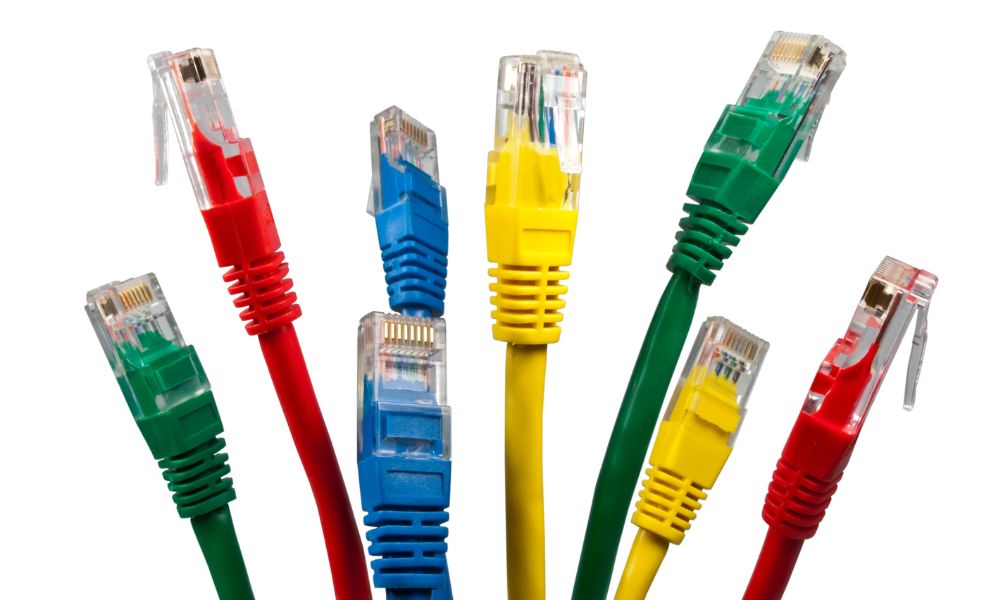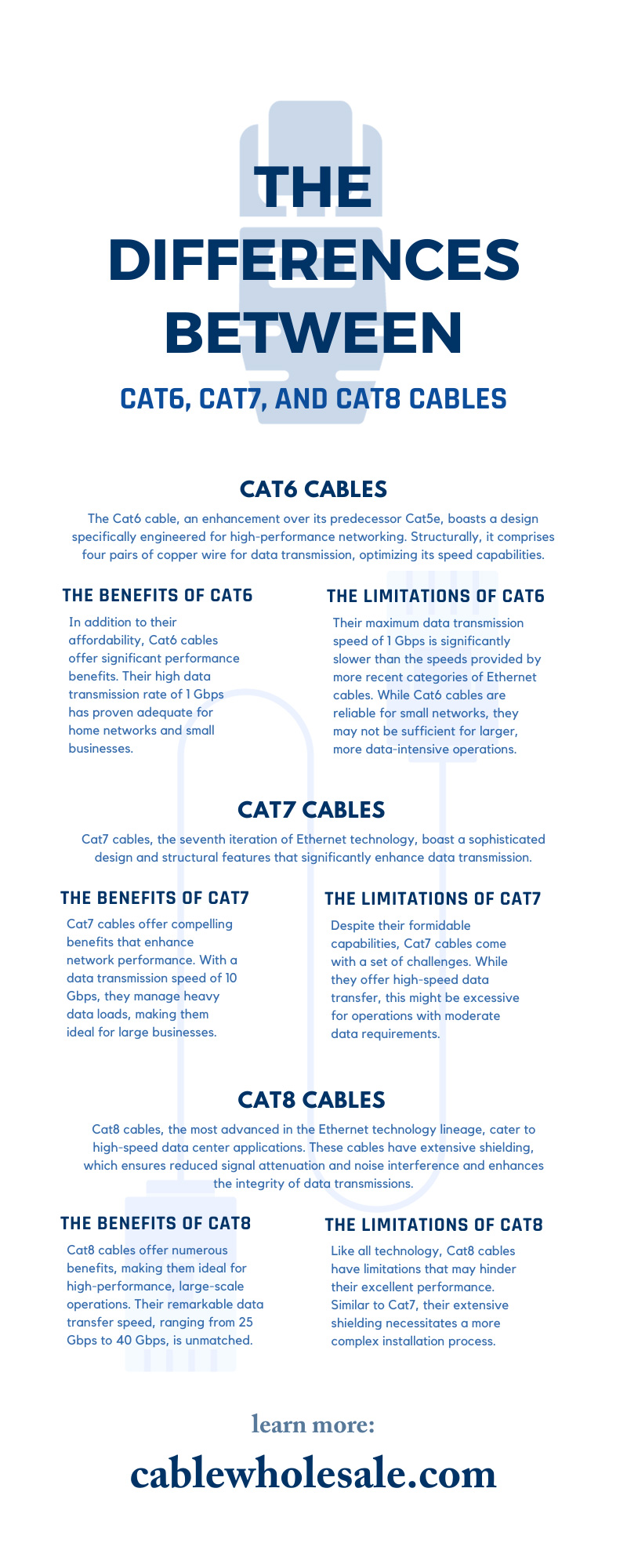
Data transmission relies heavily on networking cables, with Cat6, Cat7, and Cat8 being some of the most commonly used types in this digital era. Each category (Cat) represents a different generation of Ethernet technology, offering varying levels of performance and capacity. Understanding the differences is the best way to know which cable is best for you. Read on to learn the differences between Cat6, Cat7, and Cat8 cables to help you choose the appropriate cable for your networking needs.
Cat6 Cables
The Cat6 cable, an enhancement over its predecessor Cat5e, boasts a design specifically engineered for high-performance networking. Structurally, it comprises four pairs of copper wire for data transmission, optimizing its speed capabilities.
Cat6 cables often have a separator known as a spline to reduce interference by isolating each of the four twisted wire pairs. Its robust design features and impressive performance metrics make it ideal for demanding networking environments, such as office spaces.
The Benefits of Cat6
In addition to their affordability, Cat6 cables offer significant performance benefits. Their high data transmission rate of 1 Gbps has proven adequate for home networks and small businesses. The superior design minimizes crosstalk and network system noise, ensuring smooth and efficient data transfer. If you’re upgrading from older network systems, Cat6 cables provide the advantage of backward compatibility.
Additionally, the Cat6a, an advanced version of Cat6, provides an enhanced performance capable of further transmissions with stable connections over 100 meters. This cable is particularly suited for network environments requiring superior speed and higher frequency, such as large-scale businesses and data centers, making it a great investment for your networking needs.
The Limitations of Cat6
Despite their many advantages, Cat6 cables have a few limitations. Their maximum data transmission speed of 1 Gbps is significantly slower than the speeds provided by more recent categories of Ethernet cables. While Cat6 cables are reliable for small networks, they may not be sufficient for larger, more data-intensive operations, making it necessary to purchase Cat6a cables.
These cables have a shorter maximum distance without signal loss than their higher-category counterparts. While backward compatible with older systems, Cat6 cables aren’t future-proof. As data demands continue to rise, newer technologies may necessitate further upgrades past their limitations.
Cat7 Cables
Cat7 cables, the seventh iteration of Ethernet technology, boast a sophisticated design and structural features that significantly enhance data transmission. A Cat7 cable includes a shield for each twisted pair, significantly reducing signal interference.
Furthermore, their design includes stricter specifications for crosstalk and system noise than Cat6, ensuring more reliable data transfer. These combined elements make Cat7 an excellent choice for larger networks where high data speeds are necessary.
Despite the advanced features and capabilities of Cat7 cables, the Telecommunications Industry Association (TIA) doesn’t recognize them as a standard in the US. Cat7’s benefits, including higher bandwidth and reduced crosstalk, don’t provide a significant enough improvement over Cat6a for many American users to justify using it. Consequently, TIA doesn’t endorse Cat7 but instead promotes using Cat6a, which offers similar performance and aligns with established infrastructure standards.
The Benefits of Cat7
Cat7 cables offer compelling benefits that enhance network performance. With a data transmission speed of 10 Gbps, they manage heavy data loads, making them ideal for large businesses. A standout feature is their extended bandwidth of 100 MHz, which ensures rapid data transfer and reduces latency. Extensive shielding enhances signal integrity, reducing noise and signal attenuation.
The Limitations of Cat7
Despite their formidable capabilities, Cat7 cables come with a set of challenges. While they offer high-speed data transfer, this might be excessive for operations with moderate data requirements.
The installation process for Cat7 cables is more complex due to the extensive shielding, potentially leading to higher setup costs. As stated before, Cat 7 isn’t a ratified standard in the US, making it ineffective and challenging to acquire in most cases.
Cat8 Cables
Cat8 cables, the most advanced in the Ethernet technology lineage, cater to high-speed data center applications. These cables have extensive shielding, which ensures reduced signal attenuation and noise interference and enhances the integrity of data transmissions.
The impressive nature of their construction facilitates a maximum channel length of 30 meters, providing an advantage over their predecessors. With their superior design and cutting-edge features, Cat8 cables are the optimal choice for entities seeking the highest level of data transmission efficiency.
The Benefits of Cat8
Cat8 cables offer numerous benefits, making them ideal for high-performance, large-scale operations. Their remarkable data transfer speed, ranging from 25 Gbps to 40 Gbps, is unmatched, making them perfect for data centers and other data-heavy environments.
Their bandwidth capacity of up to 2000 MHz ensures ultra-fast data transmission with minimal latency. The Cat8 cable’s extensive shielding improves signal integrity, and the unparalleled capacity and speed provide a future-proof solution that can effectively handle the ever-increasing data transmission demands.
The Limitations of Cat8
Like all technology, Cat8 cables have limitations that may hinder their excellent performance. Similar to Cat7, their extensive shielding necessitates a more complex installation process. Additionally, the extreme capabilities of Cat8 may become wasted in operations with moderate data requirements, making them more suitable for data-heavy environments like data centers or large businesses.
Comparing Cat6, Cat7, and Cat8 Cables
When comparing Cat6, Cat7, and Cat8 cables, you must consider your specific networking needs and future requirements. Cat6 cables provide an affordable option for home and small business use, supporting 1 Gbps with a bandwidth of 250 MHz. If you require higher data rates and have larger data needs, Cat7 cables, supporting between 1 Gbps and 10 Gbps at a bandwidth of 100 MHz, could be the right choice.
However, for the most advanced and high-performance networks, such as data centers and high-speed commercial applications, Cat8 cables, supporting a staggering 25–40 Gbps at a bandwidth of 2000 MHz, are preferable. Understanding the capabilities and limitations of each category helps you make an informed decision that suits your networking needs.
How To Choose the Right Cable for Your Needs
Choosing the right Ethernet cable for your networking needs involves careful consideration of several factors. Assess your current data requirements and anticipate future needs, considering the growth and evolution of your operations. Evaluate the compatibility of the cable with your existing network infrastructure, bearing in mind that Cat7 has a low probability of functioning with other devices. Consider the possibilities of interference in your network and how much shielding you need your cables to have, as Cat7 and Cat8 cables offer more protection.
Choosing the best Ethernet cable involves numerous factors. Each cable type presents a unique balance of performance and compatibility, necessitating careful consideration. But with an understanding of the differences between Cat6, Cat7, and Cat8, selecting a cable to meet your network needs is easier.




